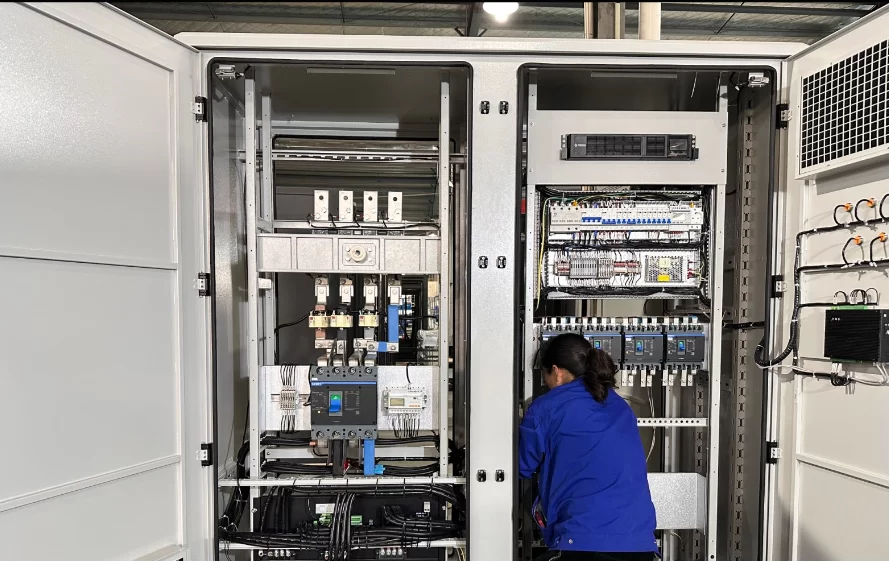What is a Grid Connection Cabinet, and What Role Does it Play?
1. Grid Connection Cabinet (or Parallel Cabinet)
A grid connection cabinet, also known as a parallel cabinet, is an electrical device used to connect two or more independent power sources, enabling them to operate in sync and supply power to a load or connect to the public grid. It typically includes components such as switching devices, protection mechanisms, control systems, and measurement instruments to manage, protect, and monitor the power system.
2. Functions of a Grid Connection Cabinet
1. Achieving Parallel Operation of Power Sources
Enhancing Power Supply Reliability: When one power source fails, other power sources can continue to supply power to the load, preventing power outages caused by the failure of a single source. For example, in a system with a backup generator and the grid, the grid connection cabinet can automatically switch to generator power if the grid fails, ensuring the continuous operation of critical equipment.
2. Increasing Power Supply Capacity:
By paralleling multiple power sources, the system can meet the power needs of larger loads. For instance, large factories or commercial buildings may require multiple generators or power inputs to meet peak electricity demand.
3. Synchronization Control
Ensuring Synchronized Operation of Power Sources: The synchronization device in the grid connection cabinet monitors the voltage, frequency, and phase between different power sources, making adjustments to ensure they remain synchronized when connected to the grid. This is crucial to avoid shock currents between power sources and to protect equipment. For example, when a generator is connected to the grid, it is essential that the generator’s voltage, frequency, and phase match the grid exactly; otherwise, it could cause severe electrical faults.
4. Protection Functions
Overcurrent Protection: If the current exceeds a preset value, the circuit breaker or fuse in the grid connection cabinet will automatically disconnect the circuit, protecting the equipment and wiring from overload damage. For example, if there is a sudden increase in load or a short-circuit fault, the overcurrent protection device will act quickly to prevent excessive current from damaging the equipment.
Short-circuit Protection: In the event of a short circuit, the grid connection cabinet can quickly disconnect the circuit to limit the short-circuit current, thereby protecting the power source and equipment. Short-circuit protection typically uses fast-acting circuit breakers or fuses that can disconnect the faulty circuit within milliseconds.
Reverse Power Protection: When a generator starts to absorb power from the grid (reverse power) instead of supplying it, the reverse power protection device will activate, preventing the generator from operating like a motor, which could damage the generator. For example, if the grid fails and then recovers, but the generator is not disconnected in time, reverse power may occur.
5. Measurement and Monitoring
Parameter Monitoring: Grid connection cabinets are equipped with measurement instruments such as voltmeters, ammeters, and power meters to monitor key parameters like voltage, current, and power in real time. This helps operators understand the system’s operating status, detect issues early, and take appropriate action.
Remote Monitoring: Some advanced grid connection cabinets come with remote communication capabilities, allowing the monitoring data to be transmitted to a central control system for remote monitoring and management. This enables operators to monitor multiple cabinets from a remote control center, improving management efficiency.
6. Improving Power Quality
Harmonic Filtering: The grid connection cabinet may include filters that reduce the impact of harmonics in the power system. Harmonics are current or voltage components with frequencies that are integer multiples of the fundamental frequency, which can cause equipment heating, increase losses, and degrade power quality. Filters effectively reduce harmonic content and improve power quality.
Reactive Power Compensation: The grid connection cabinet can automatically connect or disconnect reactive power compensation devices based on the system’s reactive power demand, improving the power factor, reducing reactive power transmission in the grid, and lowering line losses and voltage drops. For example, systems with inductive loads such as motors or transformers may require reactive power compensation to improve energy efficiency.
In distributed energy systems (e.g., solar power, small wind power, or energy storage systems), the grid connection cabinet enables the AC power generated by distributed energy sources to be connected to the public grid with the appropriate voltage, frequency, and phase. This ensures that the distributed power sources can work in coordination with the grid. For example, in a rooftop solar system in a community, the DC power generated by solar panels is converted into AC by an inverter and then fed into the community’s low-voltage distribution network via the AC grid connection cabinet. This process helps deliver clean energy to the grid for user consumption, highlighting the important role of the grid connection cabinet in power and energy storage systems.

